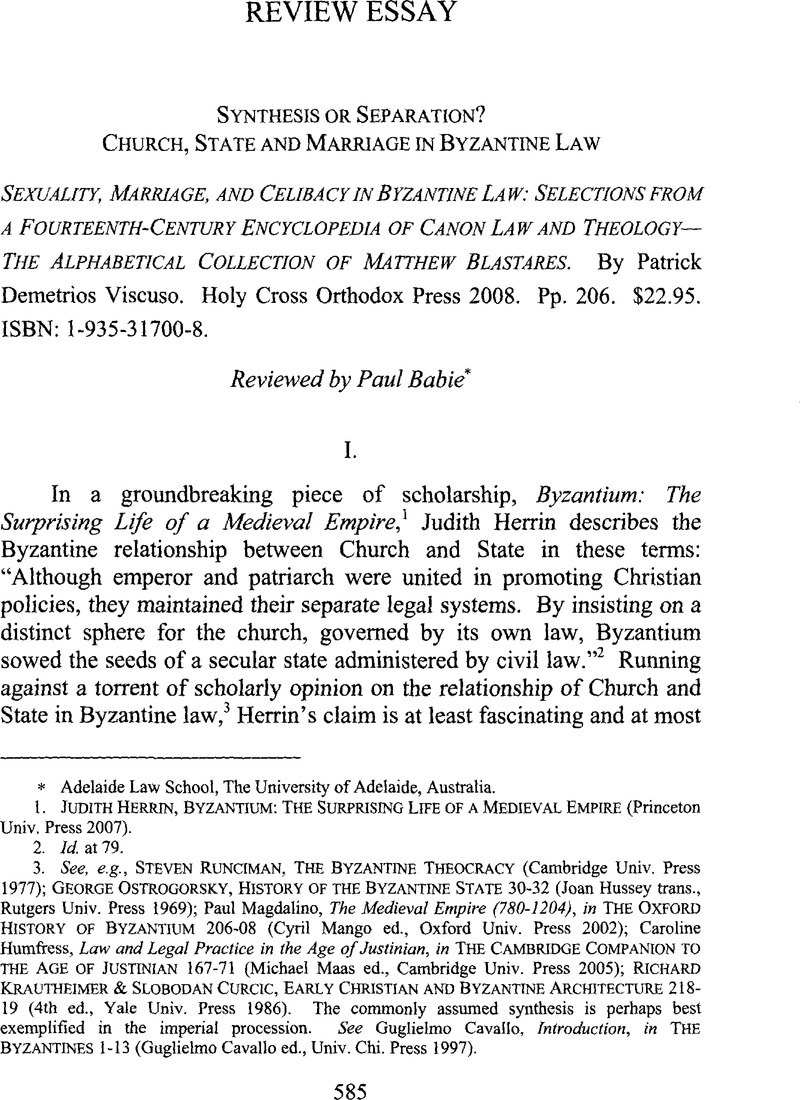Published online by Cambridge University Press: 24 April 2015

1. Herrin, Judith, Byzantium: The Surprising Life of a Medieval Empire (Princeton Univ. Press 2007)Google Scholar.
2. Id. at 79.
3. See, e.g., Runciman, Steven, The Byzantine Theocracy (Cambridge Univ. Press 1977)CrossRefGoogle Scholar; Ostrogorsky, George, History of the Byzantine State 30–32 (Hussey, Joan trans., Rutgers Univ. Press 1969)Google Scholar; Magdalino, Paul, The Medieval Empire (780-1204), in The Oxford History of Byzantium 206–08 (Mango, Cyril ed., Oxford Univ. Press 2002)Google Scholar; Humfress, Caroline, Law and Legal Practice in the Age of Justinian, in The Cambridge Companion to the Age Of Justinian 167–71 (Maas, Michael ed., Cambridge Univ. Press 2005)Google Scholar; Krautheimer, Richard & Slobodan Curcic, Early Christian and Byzantine Architecture 218–19 (4th ed., Yale Univ. Press 1986)Google Scholar. The commonly assumed synthesis is perhaps best exemplified in the imperial procession. See Cavallo, Guglielmo, introduction, in The Byzantines 1–13 (Cavallo, Guglielmo ed., Univ. Chi. Press 1997)Google Scholar.
4. Cyril Mango, Introduction, in The Oxford History of Byzantium, supra note 3, at 14-15: see aho Freeman, Charles, AD 381: Heretics, Pagans and the Christian State (Pimlico 2009)Google Scholar.
5. Papadakis, Aristeides & Kazhdan, Alexander P., Caesaropapsim, in The Oxford Dictionary of Byzantium 364, 364-65 (Kazhdan, Alexander P. ed., Oxford Univ. Press 1991)Google Scholar.
6. Runciman, supra note 3.
7. Id. at 1.
8. Id. at 3.
9. Humfress, supra note 3, at 167-71; see also Kolbert, C.F., General Introduction, in Justinian, the Digest of Roman Law Theft, Rapine, Damage and Insult 44–45 (Kolbert, C.F. trans., Penguin 1979)Google Scholar.
10. See TONY HONORÉ, TRIBONIAN (Cornell Univ. Press 1978).
11. Runciman, supra note 3, at 4.
12. Mango, supra note 4, at 15. See also Meyendorff, John, Rome, Constantinople, Moscow: Historical and Theological Studies (St. Vladimir's Seminary Press 1996)Google Scholar.
13. For recent scholarship on this issue, see Hull, Kathleen E., Same-Sex Marriage: The Cultural Politics of Love and Law (Cambridge Univ. Press 2006)CrossRefGoogle Scholar; Backer, Larry Cata, Religion as the Language of Discourse of Same Sex Marriage, 30 Cap. U. L. Rev. 221 (2002)Google Scholar; Koons, Judith E., “Just” Married? Same-Sex Marriage and a History of Family Plurality, 12 Mich. J. Gender & L. 1 (2005)Google Scholar; Brennan, Frank, Church-State Concerns about Same Sex Marriage and the Failure to Accord Same Sex Couples their Due, in Theology and Law: Partners or Protagonists? 83–111 (Parker, Christine & Preece, Gordon eds., ATF Press 2005)Google Scholar.
14. Alexander P. Kazhdan, Blastares, Matthew, in The Oxford Dictionary of Byzantium, supra note 5, at 295; see also Herrin, supra note 1, at 73-78.
15. Andreas Schminck, Nomokanones, in The Oxford Dictionary of Byzantium, supra note 5.
16. Herrin, supra note 1, at 77-78.
17. Magdalino, supra note 3, at 207.
18. These are three of the four components of the Justinian's Corpus Juris Civilis: Herrin, supra note 1, at 75.
19. Kazhdan, supra note 14. See also Herrin, supra note 1, at 77-78.
20. Indeed, United States Supreme Court Justice Joseph Story, having reviewed the role of Christianity in the common law of the United States, went so far as to say that “[t]hese and many other matters which might be noticed, add a volume of unofficial declarations to the mass of organic utterances that this is a Christian nation.”: Holy Trinity Church v. U.S., 143 U.S. 457, 471 (1892). On this see Friedman, Lawrence M., A History of American Law536–37 (3d ed., Touchstone 2005)Google Scholar; Ahlstrom, Sydney E., A Religious History of the American People (2d ed., Yale Univ. Press 2004)Google Scholar.
21. On pagans, see Treadgold, Warren, A History of the Byzantine State and Society 41, 57-63, 120-22, 125, 180, 259, 391 (Stanford Univ. Press, 1997)Google Scholar; on heretics, see Cyril Mango, New Religion, Old Culture, in The Oxford History of Byzantium, supra note 3, at 105-06; on Jews, see Steven B. Bowman, Jews, in The Oxford Dictionary of Byzantium, supra note 5; on Muslims, see Robert Hoyland, The Rise of Islam, in The Oxford History of Byzantium, supra note 3.
22. Treadgold, supra note 21, at 121, 180, 260, 350, 392.